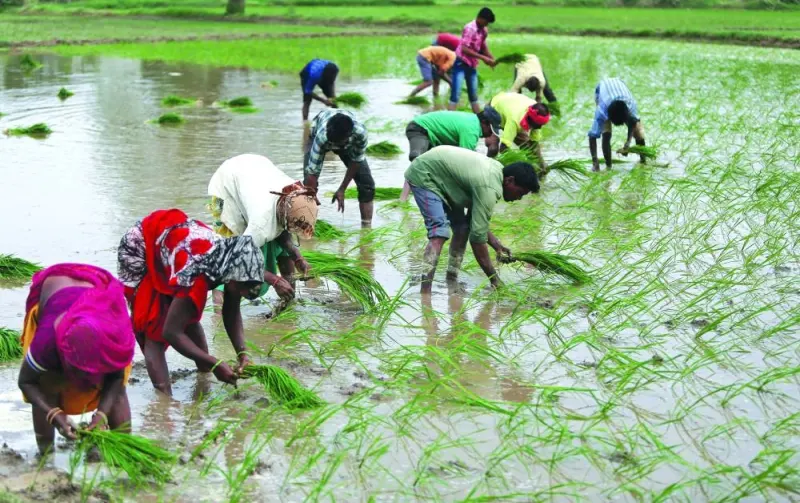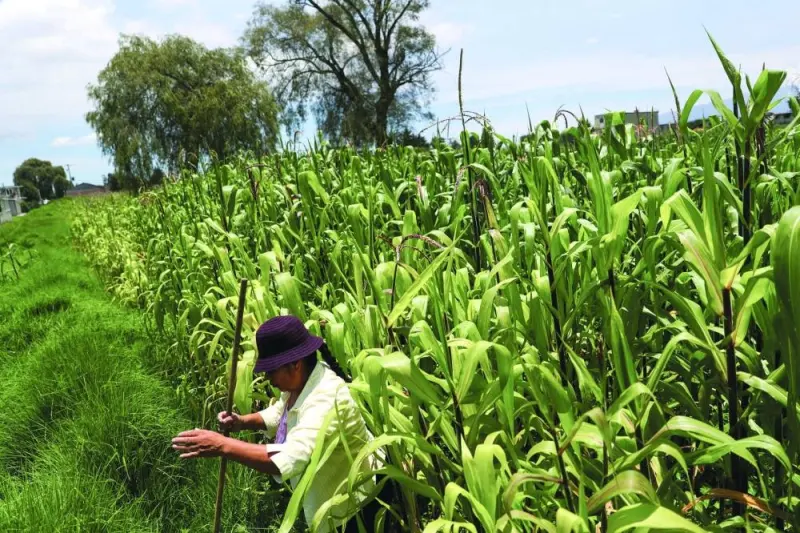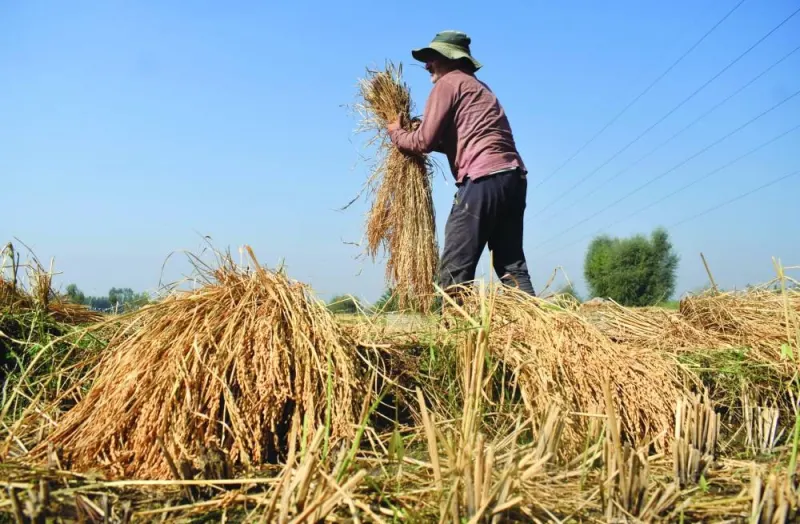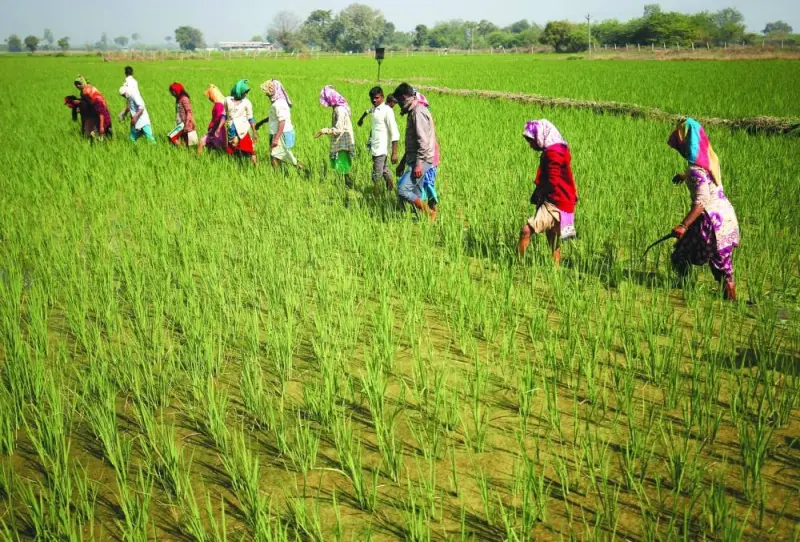• UN unveils first global roadmap to slash food emissions
• Plan aims for a ‘just transition’ in agriculture
• Experts split over use of high-emission fertilisers
BY BHASKER TRIPATHI NEW DELHILAST EDITED DECEMBER 24, 2023




The first-ever UN roadmap for cutting climate-heating emissions from the world’s farming sector, unveiled at the COP28 UN climate summit this month, has stirred debate around how to share fairly the burden of shifting to greener ways.
Some agricultural experts are calling for fertilisers and other agro-chemicals — whose production relies heavily on fossil fuels — to be completely phased out, while others say poorer countries will continue to need them to improve low crop yields.
Food systems — including growing methods, inputs like fertilisers, storage, transportation and waste — account for nearly a third of greenhouse gas emissions worldwide.
The new plan, presented by the UN Food and Agriculture Organisation (FAO), targets an end to hunger and malnutrition without breaching the most ambitious Paris Agreement goal of limiting global warming to 1.5C.
It proposes measures to boost farm productivity while emitting less methane, carbon dioxide and other greenhouse gases in 10 domains — from using clean energy and restoring soil and pastures, to reducing chemical inputs, food loss and waste.
It also aims for a “just transition” in agriculture by making a distinction between the actions that rich and poor countries should take based on “improved efficiency” and “global rebalancing” of resources for farming and food supplies.
And it proposes that wealthy countries should cut their high consumption of animal-source foods to enable developing nations to increase theirs without damaging the climate and nature.
The roadmap is the first of a set the FAO will unveil at three annual climate summits, starting with this year’s global overview and detailing next how to make food systems work better for people and the planet at the regional and country levels.
Emile Frison, of the International Panel of Experts on Sustainable Food Systems, welcomed the initial plan and “its emphasis on a just transition”. But, he added in a statement, it does not go far enough because it focuses only on incremental improvements to today’s “flawed” industrial food system.
“These efficiency-first proposals are unlikely to be enough to get us off the high pollution, high fossil fuel, high hunger track we’re on,” said the conservation and biodiversity expert.
Patty Fong, programme director at the Global Alliance for the Future of Food — which unites almost 30 philanthropic foundations — said making food systems truly sustainable would require a commitment to phase out fossil fuels along the entire value chain, from farm to fork.
The roadmap, however, calls for less fertiliser use through greater efficiency rather than a wholesale shift towards sustainable farming practices like agro-ecology, she noted.
Others argued that chemical fertilisers remain essential for boosting food security in developing countries with low crop yields and a high proportion of smallholder farmers.
Aditi Mukherji, of the CGIAR global research partnership on food systems, said solutions should be context-specific — and sustainable intensification of agriculture is needed in poorer regions with low productivity.
“But certainly, this is not true of high-income countries,” she told Context.
In many low-income countries, higher agricultural efficiency and stronger climate resilience would result in lower emissions by minimising crop losses and post-harvest waste, she noted.
INDIAN FARMERS STRUGGLE
These debates are playing out on the ground in countries like India, where agriculture is the biggest employer, supporting the livelihoods of 250mn farmers and labourers.
Their work is getting tougher as climate change makes living off farming difficult, pushing up debt, migration and even suicides. Worries over falling yields have driven rising use of chemical fertilisers in general.
But a growing number of smallholder farmers are trying out green approaches that promote organic, natural or sustainable methods. Their scale and success will hinge on how well they can protect incomes, agricultural experts told Context.
For instance, despite having heard of many farmers switching to natural cultivation methods, Shashikant Shukla continues to grow wheat and pulses using chemical inputs on his half an acre of land in northern India’s Uttar Pradesh state.
His yields and income have been squeezed by erratic monsoon rains, unseasonal downpours and early heatwaves — fuelled by climate change — together with rising costs for fertilisers and other overheads.
“I am constantly living in debt; I do not have the courage to experiment on my farm,” said Shukla, who makes up for his climate-related harvest losses by working as a driver-for-hire.
Even if he does try growing organic wheat, he would end up selling it at the same price as conventional wheat — and if it leads to a dip in yields, “it will break my back,” he added.
Switching to natural farming often causes a drop in yields in the initial years before harvests gradually pick up — something most poor Indian farmers can ill absorb.
They rely on government purchases of their staple crops such as rice and wheat at guaranteed prices, and rarely have money in reserve to change their practices without outside support.
Devinder Sharma, an independent expert on agricultural policy, told Context that India needs to move towards ecological farming practices, but green initiatives will only achieve cosmetic changes unless farmers are offered an assured income.
Smallholder farmers Context spoke to for a recent series on achieving a just green transition in Indian agriculture identified a range of challenges — from lack of access to good-quality seeds and markets with premium prices, to low availability of natural manure and high labour costs.
Sharma said they would benefit from a government-backed guaranteed price for naturally grown produce, as well as subsidies to cover any losses and stronger marketing channels.
CLIMATE FINANCE GAP
A widespread shift to low-carbon, climate-resilient food production, as outlined in the new UN roadmap, will succeed only if it puts farmers at the centre and provides the finance, infrastructure and technology they need to adapt to more extreme weather and adopt greener practices, experts said.
Another FAO report complementing the 1.5C blueprint warned that too little climate finance is flowing to agriculture.
Between 2000 and 2021, agri-food systems received about $183bn, or just 4% of overall climate finance flows, the report said, noting that the annual allocation for farming fell 12% to $19bn in 2021, while hundreds of billions are required.
Furthermore, in that same year, only 0.3% of international climate finance from public and private sources reached smallholder farmers — who will need the most support in the transition to sustainable agriculture, according to a separate analysis by Amsterdam-based think-tank Climate Focus.
They and other marginalised groups should be able to participate in working out how to transform global food systems, said Fong, of the Global Alliance for the Future of Food.
“Grassroots producers — particularly smallholder farmers, women and Indigenous communities — must be included in all discussions,” she said in a statement on the FAO roadmap. (Thomson Reuters Foundation)
BY BHASKER TRIPATHI NEW DELHILAST EDITED DECEMBER 24, 2023




The first-ever UN roadmap for cutting climate-heating emissions from the world’s farming sector, unveiled at the COP28 UN climate summit this month, has stirred debate around how to share fairly the burden of shifting to greener ways.
Some agricultural experts are calling for fertilisers and other agro-chemicals — whose production relies heavily on fossil fuels — to be completely phased out, while others say poorer countries will continue to need them to improve low crop yields.
Food systems — including growing methods, inputs like fertilisers, storage, transportation and waste — account for nearly a third of greenhouse gas emissions worldwide.
The new plan, presented by the UN Food and Agriculture Organisation (FAO), targets an end to hunger and malnutrition without breaching the most ambitious Paris Agreement goal of limiting global warming to 1.5C.
It proposes measures to boost farm productivity while emitting less methane, carbon dioxide and other greenhouse gases in 10 domains — from using clean energy and restoring soil and pastures, to reducing chemical inputs, food loss and waste.
It also aims for a “just transition” in agriculture by making a distinction between the actions that rich and poor countries should take based on “improved efficiency” and “global rebalancing” of resources for farming and food supplies.
And it proposes that wealthy countries should cut their high consumption of animal-source foods to enable developing nations to increase theirs without damaging the climate and nature.
The roadmap is the first of a set the FAO will unveil at three annual climate summits, starting with this year’s global overview and detailing next how to make food systems work better for people and the planet at the regional and country levels.
Emile Frison, of the International Panel of Experts on Sustainable Food Systems, welcomed the initial plan and “its emphasis on a just transition”. But, he added in a statement, it does not go far enough because it focuses only on incremental improvements to today’s “flawed” industrial food system.
“These efficiency-first proposals are unlikely to be enough to get us off the high pollution, high fossil fuel, high hunger track we’re on,” said the conservation and biodiversity expert.
Patty Fong, programme director at the Global Alliance for the Future of Food — which unites almost 30 philanthropic foundations — said making food systems truly sustainable would require a commitment to phase out fossil fuels along the entire value chain, from farm to fork.
The roadmap, however, calls for less fertiliser use through greater efficiency rather than a wholesale shift towards sustainable farming practices like agro-ecology, she noted.
Others argued that chemical fertilisers remain essential for boosting food security in developing countries with low crop yields and a high proportion of smallholder farmers.
Aditi Mukherji, of the CGIAR global research partnership on food systems, said solutions should be context-specific — and sustainable intensification of agriculture is needed in poorer regions with low productivity.
“But certainly, this is not true of high-income countries,” she told Context.
In many low-income countries, higher agricultural efficiency and stronger climate resilience would result in lower emissions by minimising crop losses and post-harvest waste, she noted.
INDIAN FARMERS STRUGGLE
These debates are playing out on the ground in countries like India, where agriculture is the biggest employer, supporting the livelihoods of 250mn farmers and labourers.
Their work is getting tougher as climate change makes living off farming difficult, pushing up debt, migration and even suicides. Worries over falling yields have driven rising use of chemical fertilisers in general.
But a growing number of smallholder farmers are trying out green approaches that promote organic, natural or sustainable methods. Their scale and success will hinge on how well they can protect incomes, agricultural experts told Context.
For instance, despite having heard of many farmers switching to natural cultivation methods, Shashikant Shukla continues to grow wheat and pulses using chemical inputs on his half an acre of land in northern India’s Uttar Pradesh state.
His yields and income have been squeezed by erratic monsoon rains, unseasonal downpours and early heatwaves — fuelled by climate change — together with rising costs for fertilisers and other overheads.
“I am constantly living in debt; I do not have the courage to experiment on my farm,” said Shukla, who makes up for his climate-related harvest losses by working as a driver-for-hire.
Even if he does try growing organic wheat, he would end up selling it at the same price as conventional wheat — and if it leads to a dip in yields, “it will break my back,” he added.
Switching to natural farming often causes a drop in yields in the initial years before harvests gradually pick up — something most poor Indian farmers can ill absorb.
They rely on government purchases of their staple crops such as rice and wheat at guaranteed prices, and rarely have money in reserve to change their practices without outside support.
Devinder Sharma, an independent expert on agricultural policy, told Context that India needs to move towards ecological farming practices, but green initiatives will only achieve cosmetic changes unless farmers are offered an assured income.
Smallholder farmers Context spoke to for a recent series on achieving a just green transition in Indian agriculture identified a range of challenges — from lack of access to good-quality seeds and markets with premium prices, to low availability of natural manure and high labour costs.
Sharma said they would benefit from a government-backed guaranteed price for naturally grown produce, as well as subsidies to cover any losses and stronger marketing channels.
CLIMATE FINANCE GAP
A widespread shift to low-carbon, climate-resilient food production, as outlined in the new UN roadmap, will succeed only if it puts farmers at the centre and provides the finance, infrastructure and technology they need to adapt to more extreme weather and adopt greener practices, experts said.
Another FAO report complementing the 1.5C blueprint warned that too little climate finance is flowing to agriculture.
Between 2000 and 2021, agri-food systems received about $183bn, or just 4% of overall climate finance flows, the report said, noting that the annual allocation for farming fell 12% to $19bn in 2021, while hundreds of billions are required.
Furthermore, in that same year, only 0.3% of international climate finance from public and private sources reached smallholder farmers — who will need the most support in the transition to sustainable agriculture, according to a separate analysis by Amsterdam-based think-tank Climate Focus.
They and other marginalised groups should be able to participate in working out how to transform global food systems, said Fong, of the Global Alliance for the Future of Food.
“Grassroots producers — particularly smallholder farmers, women and Indigenous communities — must be included in all discussions,” she said in a statement on the FAO roadmap. (Thomson Reuters Foundation)
No comments:
Post a Comment